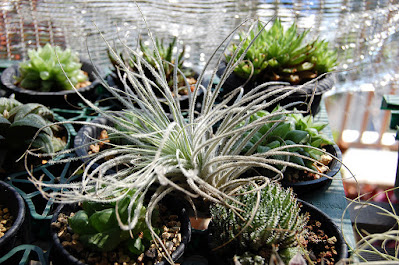Tillandsia tectorum is native to the high mountains of the Andes of Ecuador and Peru. It grows as lithophytes at 0-3000 meters above sea level in large, populations on rock outcroppings and cliff face amid cacti, but elevation and associated fog belts may influence occurrence more than local geology...
Tillandsia tectorum also called as Rooftop Tillandsia, Rock Airplant, Roof Air Plant, Tillandsia argentea, Tillandsia rupicola, Tillandsia saxicola, Tillandsia tectorum f. gigantean, Tillandsia tectorum var. globose, Tillandsia tectorum var. viridula, is a species of the genus Tillandsia. This species was described by Charles Jacques Édouard Morren in 1877.
IDENTIFY TILLANDSIA TECTORUM
Tillandsia tectorum is native to the high mountains of the Andes of Ecuador and Peru. It grows as lithophytes at 0-3000 meters above sea level in large, populations on rock outcroppings and cliff face amid cacti, but elevation and associated fog belts may influence occurrence more than local geology. This species, although often common in favorable sites, exhibits greater insularity consistent with the vertically compressed (cloud zones) and horizontally dissected nature of its montane habitats.
It is an evergreen, epiphytic perennial, to 30 cm tall and 20 cm across, with very narrow triangular, filiform-attenuate, white to ash-grey, striate, 12-25 cm long, sheaths amplexicaul, triangular-ovate, 15-30 mm wide at base leaves, covered with fuzzy white hairs.
Small, tubular purple-violet flowers emerge from pinkish-purple bracts in spring and summer. The flowers are hummingbird pollinated. Once a rosette has flowered, it will die but not before smaller rosettes appear at its base to replace it.
TILLANDSIA TECTORUM CARE AND CULTURE
Cultural information should only be used as a guide, and should be to be adapted to suit you. Your physical location; where you grow your plants, how much time you have to devote to their care, and many other factors, will need to be taken into account. Only then can you decide on the cultural methods that best suit you and your plants.
Light and temperature:
Tillandsia tectorum needs a lot of light, which is explained by the fact that only 50-60% of the available light comes from the leaves as the rest is shielded and reflected by its trichomes. It is therefore placed in full sun during the cooler seasons, but in summer it is better to protect it from direct sunlight, because it does not react well to excessive heating of the leaves.
You can hold this species in front of a window facing south and sheltered by an organza curtain. In this way, part of the sun's rays is shielded, but the intensity of the light remains high: on values close to 27000-30000 lux.
The required temperature ranging from 10 to 32°C. It is possible to keep this plants outdoors, but it must be sheltered from the rains: the excessive water spoils the trichomes and brings the plant to lose its spectacular appearance and rot.
Mounting:
This species refer to be mounted on a solid substrate that does not retain water. You can glue the plant directly to the surface with a strong adhesive, or you can wire the plant to the base. Don't cover the base of the plant with moss or it may rot. It can be grown on almost any imaginable decorative mount, including shells, rocks, slate, driftwood, etc. Group them in decorative clumps for maximum effect.
Watering:
Tillandsia tectorum in the wild receives very little water from the rains and the humidity comes in the form of very frequent mists. For this reason it is certainly not true that it should be watered at most once a month, in fact, it really appreciates the regular watering.
You just have to remember that it does not get water in the classic way, spraying it abundantly or watering it with a jet, but the water must be vaporized to resemble a fog as much as possible. The leaves should never be soaked with water.
It is recommended to water the plant every 2-3 days in summer and every 4-5 days in winter, with air humidity equal to 60%. If the plant receives too much water, it loses its trichomes and the leaves become much smoother and green; this can be followed by a deformation of the young leaves and the decay of the plant.
Fertilizer:
Tillandsia tectorum does not fertilize like the others: in nature it grows in extreme conditions and the nutrients that can be obtained are few. It is fertilized every 30-45 days, depending on the period, diluting a little of the fertilizer used for orchids in the watering water. 1/6 of the dose indicated on the fertilizer bottle is used.















COMMENTS